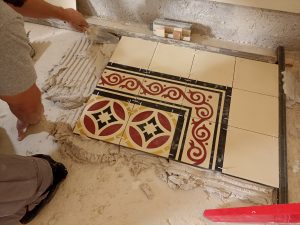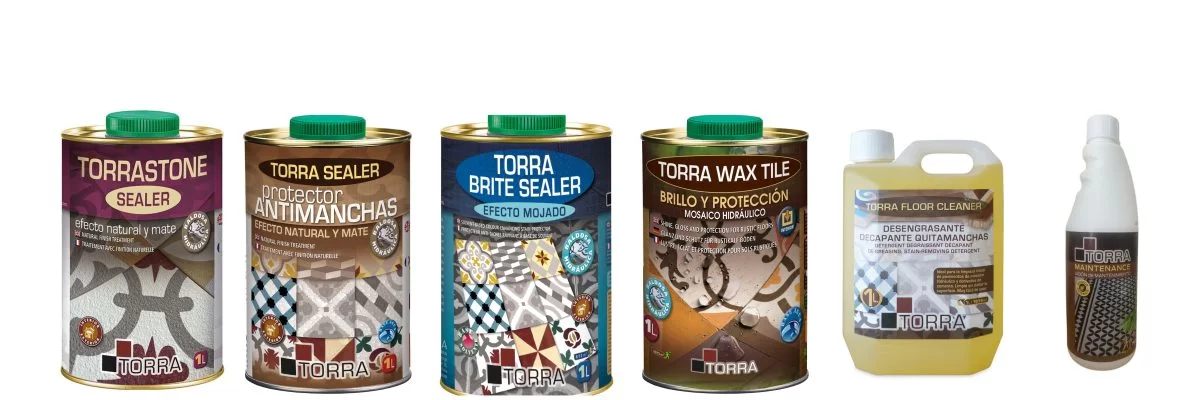You've chosen your hydraulic cement tile floor; you've already selected from thousands of designs and materials. You lay it according to the instructions, but there comes a time of year when the hydraulic floor rises, causing aesthetic problems, and even leading to materials breaking. These are the 2 reasons why this happens, just to give you an idea.
The cement tile rises, but it's not a mystery
When hydraulic floor tiles lift, it's not because they are of poor quality or because the cement adhesive hasn't done its job. Simply put, it's because there are 2 major factors to consider. Here are the 2 reasons:
- Moisture
The great enemy of old or modern hydraulic cement tiles is moisture, both indoors and outdoors. Most of these little accidents happen in summer with high temperatures or in winter when temperatures are very low, where temperature changes affect the design and cause materials to lift or expand. You must consider this when working in places with extreme cold or unbearable heat.
Why is moisture the problem? This issue can seep in from everywhere. In the case of hydraulic cement tiles, if they are not sealed and waterproofed, moisture will reach the concrete slab, so in one way or another, all the vapor has to come out. In short, your floor is going to breathe.
- Poor work on the subfloor
Number 2 goes hand in hand with number 1. Moisture enters and exits for one simple reason: the subfloor, present in all works of this type, is of poor quality, simply not thick enough for the climatic conditions of the place.
The hydraulic floor rises, but it has a solution. Especially, in the hands of professionals.
Tips for the installation of encaustic cement tiless
Once the surface where the tiles or encaustic cement tiless are to be placed is leveled and filled, the pieces should be placed for presentation to ensure the result before installation. If a traditional carpet format is chosen, it should start from the centre of the design, then place the edge pieces, and finally place the outer pieces and cut them as required using a wet disc or grinder.
Tile Preparation
Good preparation of the hydraulic cement tile is essential to guarantee its subsequent maintenance and a high-level result once the installation is done. First, and once all the pavement is installed, it is advisable to wash each of the tiles with neutral liquid soap mixed with water. It is important not to use any type of abrasive liquid such as bleach or ammonia, and nothing that could deteriorate the appearance of the hydraulic cement tile.
Once the liquid soap and water solution has been applied, it is very important to wait for the floor to be completely dry to prevent the appearance of stains. After completing this step, it would be necessary to apply a pore-sealing product that will prevent stains caused by future accidental spills; here we would recommend using our Torra sealer waterproofing product.
The work done when laying the hydraulic cement tiles may cause water evaporation, leading to the appearance of whitish calcification deposits. However, they will disappear easily with neutral soap washing, you can also use our Torra floor cleaner product for more effective cleaning.
By following these simple steps, we will prepare the pavement and protect it from humidity, stains, and daily wear. Subsequently, only periodic maintenance will be necessary, which will preserve all the properties of the hydraulic cement tile using our daily-use product Torra maintenance, which will clean and preserve the shine of your hydraulic floor.
Installation:
With the help of a sponge, wet the surface completely to facilitate the adhesion of the mosaic and the tile adhesive.
Apply the adhesive to the surface of the floor evenly, next step place the adhesive on the piece, what we would call double gluing, try to brush the adhesive in the same direction on both surfaces, otherwise, the air bubbles that remain trapped can cause the mosaic or cement tile to lift.
It is recommended not to use any black rubber mallet as it could stain the pieces, instead, it should be pressed with the palm to position it correctly and level it. Pay attention to the leveling of the mosaics because, unlike marble and granite, mosaics cannot be leveled with a polisher as we would damage the hydraulic floor in a completely irreversible way.
Avoid leaving adhesive residues on the pieces as once dry, it hinders their cleaning. When the installation is finished, in case the hydraulic floor is very dirty with residues from the work itself, we recommend cleaning it with our Torra floor cleaner product, carefully read our instruction manual for its correct application.
As you can see, the installation of mosaics and hydraulic cement tiles seems simple, however, it has its problems and risks, so it is recommended to hire specialised and trained people to obtain a good job, saving time and money.

Protection of the cement tile
When it comes to installing cement tiles, it is essential to pay attention to every detail to ensure impeccable results. Perfect alignment and leveling of each tile are essential to achieve a visually attractive and durable finish. However, meticulous installation is not enough; subsequent care is equally crucial.
The sealer plays a vital role in maintaining and protecting cement tiles. Beyond improving their appearance, it acts as a barrier against the absorption of difficult stains, reducing their porosity and extending their useful life. It is essential to use our Torra sealer waterproofing to preserve the beauty and integrity of the tiles without altering their original appearance.
When applying the sealer, it is essential to ensure that the surface is completely clean and dry. Using a roller or a 20 cm brush, which is the width of most cement tiles used, facilitates the task and allows reaching difficult corners easily. Precision in the application of the sealer is key; an excess of product could leave unwanted stains. Therefore, carefully follow the instructions that Mosaics Torra has on each of its products, and this will guarantee optimal protection without compromising the aesthetics of the cement tiles.
It is worth noting that before applying the sealer, it is advisable to test on a small piece of tile to observe the reaction. From there, we can carry out the sealing process safely.
Now that I have the floor installed I am thinking of buying a encaustic cement tiles, but... What maintenance should I do? Both indoors and outdoors, encaustic cement tiles requires regular maintenance. This maintenance allows you to preserve the floor and reinforce the protective layer of waterproofing treatment.
For daily cleaning, neutral soaps can be used (no acids) and once a week, scrub the floor by diluting a glass of Torra wax tile in a bucket of water. This way, we clean the cement tile and the normal dirt while nourishing and restoring the treatment of the floor.
Tips for caring for the mosaic
In this post, we want to give you some tips to keep your hydraulic floor impeccable like the first day.
Cleaning: What is the floor stained with?
For each type of stain, we will use the most appropriate cleaning product. Torra Floor Cleaner is ideal for cleaning construction residues, cement, and salt efflorescences. For other types of stains, you will have to use a neutral soap or other specific cleaner. You can contact us for advice.
Treatment: How to treat indoor cement tiles? And outdoor tiles? Is it necessary?
Treating the floor means saturating the porosity of the pieces, protecting them against all types of domestic stains while maintaining the natural tonality or intensifying it with a wet effect enhancing the colours of the pieces. Therefore, necessary and 100% recommended. Treatment products act as hydrophobic and
oleophobic, that is, they waterproof the pieces while maintaining the tone or enhancing the natural beauty of the encaustic cement tiles floors. We have two products (both for indoor and outdoor use):
TORRA SEALER if we want to treat the floor maintaining the natural tone,
TORRA BRITE SEALER to treat the hydraulic floor revitalizing the colours and achieving a wet effect and satin finish.
These products help protect against atmospheric conditions indoors, against the emergence of salt efflorescences, and domestic stains.
TORRA STONE SEALER has an anti-ice effect and a natural and matte finish. Ideal for keeping your outdoor hydraulic floors in perfect condition or humid areas.
And the Wax for the hydraulic floor? To apply or not.
What do experts recommend? If we want to get a more intense and uniform shine and leave the floor much softer to facilitate ordinary maintenance, we can apply liquid noble wax on the waterproofing here we would recommend our TORRA WAX TILE wax. In addition, this will protect the hydraulic floors in an additional way.





